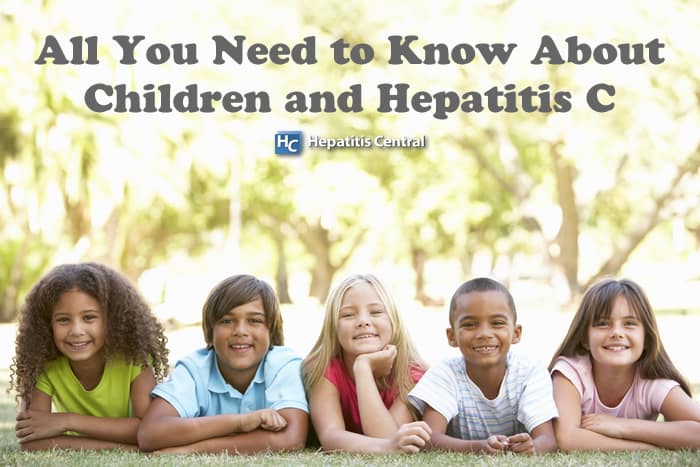All You Need to Know About Children and Hepatitis C


Hepatitis C, a blood borne virus that can lead to liver fibrosis, cirrhosis and even cancer, is a growing health problem for children. Over 3 million pediatric patients globally and 50,000 U.S. children are estimated to be infected with hepatitis C (HCV). (1) If not treated early, children who are frequently asymptomatic may progress on to fibrosis, cirrhosis, or end-stage liver disease.
How Do Children Get HCV?
Before 1990, the manner by which children were infected with HCV was by use of transfusion of blood or blood products, but current cases are coming more from vertical transmission or from mother to child passed on during childbirth. It is estimated that the rate of mother to child transmission is 5% (1) and may be as high as 14% in women with dual infections of HIV and HCV (2).
Other ways children can get HCV are: (2, 3)
- Receiving blood products from an infected person
- Receiving an infected transplant or long-term kidney dialysis
- Having unprotected sexual contact with predators or early sexual experimentation
- Sharing items such as razors, syringes or needles that may have tainted blood on them
What Are Ways You Will Not Transmit HCV?
Many misconceptions surround HCV and how it is transmitted thus ostracizing children from needed social contact and human interaction. Some of the ways you cannot transmit HCV include: (3)
- Hugging
- Kissing
- Sneezing
- Coughing
- Food
- Water
- Casual contact
What Happens if I am Pregnant with HCV?

Treatment during pregnancy for HCV is usually contraindicated because the drugs used for treatment such as ribavirin may cause birth defects. All pregnant women, however, should be tested for HCV to plan for future interventions for both mother and child. (4)
Babies with moms who are positive for HCV can still breastfeed as long as the nipples are not cracked, or bleeding or there is no coinfection with HIV. Breastfeeding and room sharing are encouraged for HCV positive moms.
What Happens if a Baby is Born with HCV?
Although testing can be done earlier, current recommendations are to wait until the baby is 18 months old before an antibody-based test, such as HCV-RNA, is used to determine infectivity. The reason for waiting is the fact that the baby might clear the infectious hepatitis virus on its own and the presence of mom’s antibodies may persist in the baby for up to 18 months.
About 25-50% of infected infants spontaneously clear themselves of their HCV infections by 4 years of age. (5) Early detection simply allows for efficient tracking and early implementation of care when needed. A child who tests positive should be rechecked six months later to determine chronic nature of infection. Treatment before age 3 is not advised.
There is no vaccine for HCV. Identifying, following, and treating children is recommended. (5)
Early Guidance for the HCV Positive Child
Parents should be informed that hepatitis C is not contracted by casual touching or playing, and social play dates should be encouraged with other children and regular school activities should be maintained inclusive of athletic activities.
Parents should be instructed in universal precautions, and they should work with the child to teach the same principles in real life situations. The family should be aware of the modes of HCV transmission. They should also be aware of the techniques for avoiding blood exposure, such as not sharing toothbrushes or nail clippers, and the use of gloves and diluted bleach to clean up blood should be reviewed with the child in an age-appropriate manner. (4, 5, 6)
What Are the Symptoms of HCV Infection?
Symptoms of active infection include:
- Loss of appetite
- Fatigue
- Yellowing of the skin or eyes
- Dark urine
- Stomachaches and/or diarrhea
- Light-colored stools
Treatment Guidelines for the Child with HCV
If a child that tests positive initially is still positive six months later, they are considered to have a chronic HCV infection. From the time the child contracts the virus it takes about two weeks to show up in the blood, but the incubation period is likely to be six to nine months before any symptoms express if they are expressed at all.
Pegylated interferon in combination with ribavirin used to be the only approved treatment for children under 12 years of age. (7) However, this form of treatment was fraught with problems from the start. Not only was it lacking in effectiveness, it caused hypothyroidism in many of its patients. One study observed hypothyroidism in 28% of its patients treated with interferon.
Furthermore, it was discovered that this form of treatment could induce autoimmune diseases such as autoimmune thyroid disease. (8) Interferon is no longer recommended for any age group due to its side-effects.
Treatment regiments vary based on age, weight, medication, stage of illness and which of the 6 genotypes the child has.
Treatment protocols can be contradictory between studies and organizations. However, despite this, guidelines have been proposed for the various age groups by the Infectious Diseases Society of America. (5)
Treatment Guidelines for the Child Ages 3-5
This is the population with the least amount of data. Two regimens are used for this age group.
- A combination of ledipasvir and sofosbuvir (LDV/SOF) are used for genotypes 1, 3, 4, 5, and 6 at 12- and 24-months duration depending on the presence or absence of cirrhosis.
- A combination of SOF and ribavirin (RBV) are used for genotypes 2 and 3.
Sustained viral response was 97% and 92 % respectively in the studies using these dosage regimens.
Treatment Recommendations for age 6 -11
For age 6 and older, sofosbuvir and velpatasvir are preferred for any genotype as long as the weight is at least 37 pounds.
The most common adverse reactions observed were fatigue and headache, similar to those observed in adults. (9)
Hepatitis B (HBV) reactivation may also occur which could result in kidney failure and even death. Health care providers should test all patients for evidence of current or prior HBV infection before initiation of Epclusa and continue to monitor the patient throughout treatment. (9, 10)
Treatment Guidelines in Adolescents Age 12-17
Treatment with ledipasvir and sofosbuvir over 12 weeks resulted in sustained viral reduction in genotypes 1, 4, 5 and 6 infections without cirrhosis or with compensated cirrhosis.
Also on the treatment table for this age group from the DORA study was an 8-week treatment course of a drug combination of glecaprevir and pibrentasvir. An FDA approval for use of these two medications quickly followed completion of this study. (5)
There is the risk of reinfection. As such, it is important to education the adolescent group who may want to begin experimenting with drugs and sex. Thus, risk counseling is important for all adolescents to prevent transmission of the virus while awaiting HCV antiviral therapy and reinfection after sustained viral response is achieved. Use of alcohol, illegal drugs, and unprotected sex should be topics of conversation. (1, 5)
Treatment Considerations Beyond Cirrhosis and End-Stage Liver Disease
The 10-year cost of treating pediatric HCV infection in children is estimated at $199-336 million. That’s because many of these patients have a plethora of other confounding health issues, such as learning disabilities, developmental delays, and cognitive deficits.
There is more at stake with early treatment than avoiding long term complications; there are also current quality of life issues to contend with. This is a factor to consider when thinking about delaying treatment in hopes that the virus will resolve on its own.
It is important to note that as helpful as antivirals can be, they come at a potential cost in the form of drug interactions. The direct antivirals, or DAAs, may interact with antiseizure medication and select estrogen containing products. Everyone on a DAA should have a drug interaction check done. Drugs that increase rate of fibrosis should be avoided. (1, 5)
Conclusion
A position paper from the Federation of International Societies of Pediatric Gastroenterology, Hepatology, and Nutrition comparing the recommendations for treatment of chronic hepatitis C virus in children was able to summarize the state of the art in the following manner: (11)
- Direct-acting antivirals are safe and effective for the treatment of hepatitis C in children and adolescents.
- The strategic management approach to adolescents and children with chronic hepatitis C virus infection remains controversial.
- There is consensus on avoiding interferon-based therapy in all age groups in children.
Specific recommendations regarding which DAA regimens to use and the treatment duration varies significantly. - There is agreement among various scientific bodies that treatment with early DAA therapy should be initiated in children past 4 who are HCV positive. However, there are few studies on children on DAA therapy and none could be found on long-term follow-up. Additional studies are needed in this population to refine screening and treatment guidelines.
- Kim, N.R, Kullar, R., Khalil, H., Saab, S. (2020). Meeting the WHO hepatitis C virus elimination goal: review of treatment in paediatrics. Viral Hepatitis Wiley, 27:762-769. Retrieved from https://doi.org/10.1111/jvh.13317
- Rosenthal, P., Schwarz, K.B., Gonzalez-Peralza, R.P., Lin, C-H., Kelly, D.A., Nightingale, S., Balistreri, W.F... (2020). Sofosbuvir and ribavirin therapy for children aged 3-12 years with hepatitis C virus genotype 2 or 3 infection. Hepatology,71(1):31-43. Retrieved from https://doi.org/10.1002/hep.30821
- Hepatitis C. (n.d.) Children’s Hospital of Philadelphia. Retrieved 8/13/2020 from https://www.chop.edu/conditions-diseases/hepatitis-c
- Hertz, D. (2014, November 3) What if I give my baby hepatitis C? Retrieved from https://www.healthline.com/health-news/what-if-i-give-my-baby-hepatitis-c-110314#1
- HCV in children. (n.d.) Infectious Disease Society of America. Retrieved 8/13/20 from https://www.hcvguidelines.org/unique-populations/children
- Hepatitis C in children: symptoms and treatment. (2020). UPMC Children’s Hospital of Pittsburgh. Retrieved 8/13/2020 from https://www.chp.edu/our-services/transplant/liver/education/liver-disease-states/hepatitis-c
- Indolfi, G., Thorne, C., Sayed, M.H. Giaquinto, C. Gonzalez-Peraulta, R.P. (2017). The challenge of treating children with hepatitis C virus infection. J. of Pediatric Gastroenterology and Nutrition, 64(6):851-854. Retrieved from https://journals.lww.com/jpgn/FullText/2017/06000/The_Challenge_of_Treating_Children_With_Hepatitis.4.aspx
- Rashed, Y.K., Khalaf, F.A., Koth, S.E. (2020) Thyroid disturbances in children treated with combined pegylated interferon-alpha and ribavirin for chronic hepatitis C. CEP, 63(2):52-55. Retrieved from https://www.ncbi.nlm.nih.gov/pmc/articles/PMC7029667/
- FDA approves new treatment for pediatric patients with any strain of hepatitis C. (2020, March 19). S.D.A. Retrieved 8/13/2020 from https://www.fda.gov/news-events/press-announcements/fda-approves-new-treatment-pediatric-patients-any-strain-hepatitis-c
- Aschenbrenner, D., (2020, July). Epclusa approved for children with hepatitis C. AJN, 120 (7):26-27. Abstract retrieved from https://doi.org/1097/01.NAJ.0000688200.74686.e6
- Indolfi, G., Fischler, B., Gonsalez-Peralta, R.P., Ciocca, M., Porta, G., Neelam, M., El-Guindi, M., Kelly, D… (2020) Comparison of recommendations for treatment of chronic hepatitis C virus infection in children and adolescents: a position paper of the Federation Of International Societies of Pediatric Gastroenterology, Hepatology , and Nutrition, 70(5):711-717. Retrieved from https://journals.lww.com/jpgn/Fulltext/2020/05000/Comparison_of_Recommendations_for_Treatment_of.30.aspx.







